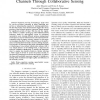Free Online Productivity Tools
i2Speak
i2Symbol
i2OCR
iTex2Img
iWeb2Print
iWeb2Shot
i2Type
iPdf2Split
iPdf2Merge
i2Bopomofo
i2Arabic
i2Style
i2Image
i2PDF
iLatex2Rtf
Sci2ools
107
click to vote
JCM
2007
2007
Opportunistic Spectrum Access in Fading Channels Through Collaborative Sensing
— Spectrum scarcity is becoming a major issue for service providers interested in either deploying new services or enhancing the capacity for existing applications. On the other hand, recent measurements suggest that many portions of the licensed (primary) spectrum remain unused for significant periods of time. This has led the regulatory bodies to consider opening up under-utilized licensed frequency bands for opportunistic access by unlicensed (secondary) users. Among different options, sensing-based access incurs a very low infrastructure cost and is backwardcompatible with the legacy primary systems. In this paper, we investigate the effect of user collaboration on the performance of sensing-based secondary access in fading channels. In particular, we demonstrate that under independent fading or shadowing, a low-overhead collaboration scheme with a very simple detector as its building block, 1) improves the spectrum utilization significantly, 2) enables the individual users to ...
Related Content
| Added | 15 Dec 2010 |
| Updated | 15 Dec 2010 |
| Type | Journal |
| Year | 2007 |
| Where | JCM |
| Authors | Amir Ghasemi, Elvino S. Sousa |
Comments (0)

